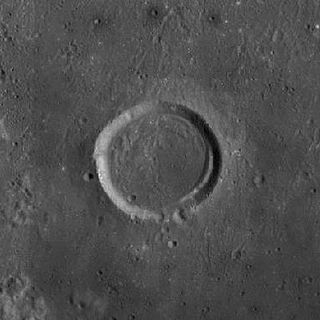
Hohmann is a lunar impact crater that lies within the central basin of the Mare Orientale formation, on the farside of the Moon. It is located to the south of the crater Maunder, and to the west of Kopff crater. Due to its proximity to the western lunar limb, this area of the surface is occasionally visible during favorable librations. However the basin is viewed from the side, restricting the amount of detail that can be observed from Earth.

Bohr is a lunar impact crater that is located near the western lunar limb, in the area that is affected by librations. It is attached to the southwestern rim of the larger, eroded Vasco da Gama formation, and to the southeast of the crater Einstein. The crater was observed for the first time in 1963, by Arthus and Ewen Whitaker in the book Rectified Lunar Atlas.
Lagrange is a lunar impact crater that is attached to the northwestern rim of the crater Piazzi. It lies near the southwestern limb of the Moon, and the appearance is oblong due to foreshortening. To the northwest of this feature is the Montes Cordillera, a ring-shaped mountain range that surrounds the immense Mare Orientale impact basin.

Catalán is a small lunar impact crater that lies almost along the southwest limb of the Moon. At this position the crater is ill-suited for observation from the Earth as it is viewed almost from the side, and visibility is subject to libration effects. It lies to the west of the somewhat larger crater Baade, and south-southeast of Graff. This region is located in the outer southeastern part of the skirt of ejecta that surrounds the Mare Orientale impact basin, and the nearby surface is rugged and streaky. This crater is named after the Spanish scientist Miguel Antonio Catalán Sañudo (1894–1957) for his contributions to spectroscopy, an important exploratory tool in astronomy.
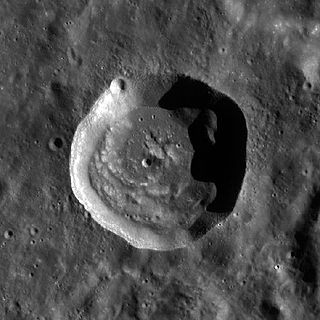
Chant is a lunar impact crater that is located on the far side of the Moon, behind the southwest limb as seen from the Earth. It lies within the southwestern part of the blanket of ejecta surrounding the Mare Orientale, beyond the Montes Cordillera mountain ring. To the west-northwest is the large walled plain Blackett. Southward is the crater Mendel.

Chadwick is a lunar impact crater that lies on the far side of the Moon's surface, just beyond the southwestern limb. It is located to the northwest of the crater De Roy, and was previously designated De Roy X before being given its current name by the IAU. This region of the lunar surface lies at the southern end of the ejecta blanket that surrounds the Mare Orientale impact basin.

Hartwig is a lunar impact crater that is located near the western limb of the Moon. It is attached to the eastern rim of the prominent crater Schlüter, to the northeast of the Montes Cordillera mountain range that surrounds the Mare Orientale. To the east-northeast of Hartwig is the larger crater Riccioli.

Graff is a small lunar impact crater that lies along the southwestern limb of the Moon. It is located to the west of the Vallis Bouvard depression in the southern part of the ejecta blanket that surrounds the Mare Orientale impact basin. To the south-southwest is the smaller crater Catalán.
Piazzi is an impact crater that is located near the southwestern limb of the Moon, and is attached to the southeastern rim of the walled plain Lagrange. About three crater diameters to the south is the crater Inghirami. Piazzi is seen at an oblique angle from the Earth, and it appears oblong due to foreshortening.

Chalonge is a lunar impact crater that is located on the far side of the Moon. It lies to the southwest of the larger crater Lewis, in the outer skirt of ejecta that surrounds the Mare Orientale impact basin. To the southeast are the Montes Cordillera, a ring of mountains that encircle the Mare Orientale formation.

Elvey is a lunar impact crater that is located on the far side of the Moon. It is located near the northern edge of the blanket of ejecta that surrounds the Mare Orientale impact basin. To the north of Elvey is the smaller crater Nobel.
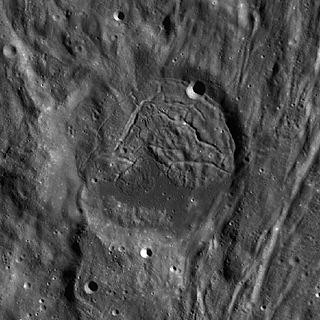
Fényi is a small lunar crater on the far side of the Moon. It lies near the southern edge of the huge, braided skirt of ejecta that surrounds the Orientale impact Basin to the north. Less than two crater diameters to the southwest is the much larger crater Mendel.

Fridman is the remains of a lunar impact crater on the far side of the Moon. It lies due south of the huge walled plain Hertzsprung, and is attached to the northeastern rim of the crater Ioffe.
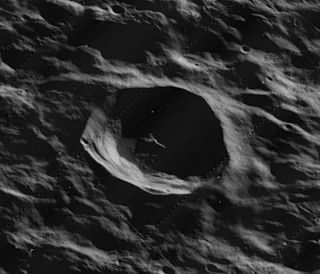
Grachev is a lunar impact crater on the far side of the Moon. It lies to the northwest of the Mare Orientale impact basin, in the outer skirt of ejecta surrounding the Montes Cordillera mountain ring. Passing along the southwestern edge of Grachev is the Catena Michelson, a valley-like formation composed of a linear chain of small craters. This feature is radial to the Mare Orientale basin. To the north is the crater Leuschner.
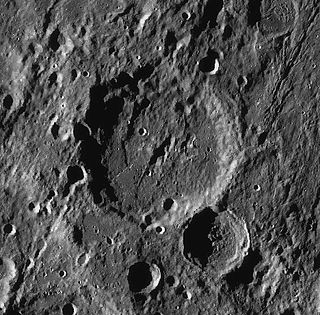
Mendel is a large Impact crater that lies on the far side of the Moon. It is located in the southern fringe of the huge skirt of ejecta that surrounds the Mare Orientale impact basin. To the south-southwest of Mendel is Lippmann, an even larger crater.
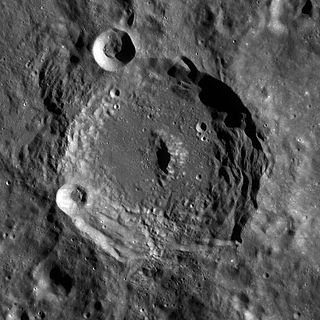
Langmuir is an impact crater on the Moon's far side. It is located in a region to the southwest of the Mare Orientale impact basin. Langmuir is bracketed between two larger craters, with Chebyshev to the west-northwest and Brouwer to the east. It partly overlaps the rims of these two craters, making it the youngest of the three. The outer rampart of ejecta from Langmuir partly covers the southeast interior floor of Chebyshev.
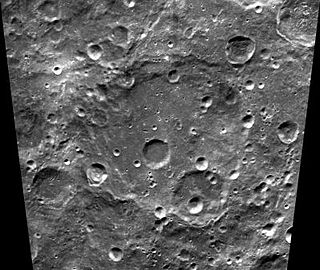
Lippmann is a large lunar impact crater in the southern part of the far side of the Moon and so cannot be viewed directly from the Earth. Just to the northeast is the walled plain Mendel, only slightly smaller than Lippmann. To the south-southeast lies the crater Petzval.

Stetson is the remains of a crater on the far side of the Moon. The northeastern part of the rim of Stetson has been overlain by the larger crater Blackett. Lying across the eastern rim is a double-crater formation consisting of the satellites Stetson E and Stetson G. There are also small craters along the southeast and northwestern rims.
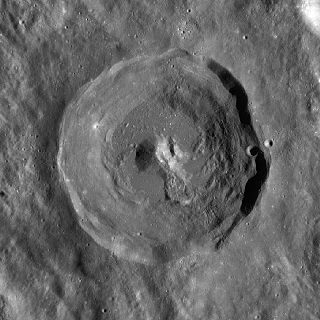
Leuschner is a lunar impact crater that is located on the Moon's far side, to the northwest of the Montes Cordillera. It lies to the north of the crater Grachev, in the outer skirt of ejecta surrounding the Mare Orientale impact basin. This is a circular crater with a rim that has only been lightly eroded by subsequent impacts. Within the interior floor is a central ridge formation.

Pease is a lunar impact crater that lies in the north-northwestern edge of the huge skirt of ejecta that surrounds the Mare Orientale impact basin. It lies just over one crater diameter to the east of the smaller crater Butlerov. To the east-northeast of Pease is the somewhat larger Nobel.





















